I have wanted to take photographs since I first understood that all the cool paper photos filling albums and crates came from these little magic boxes. My first camera was a Kodak Brownie Reflex my mother finally surrendered and allowed me to use after much begging and pleading.

In those days everyone did not carry a camera phone in their pocket. Taking photos was a special event and conducted only when special events happened, such as Easter photos of the kids all dandied up or relatives from out of town visiting. A roll of film with 12 shots might last an entire year or even longer back then. Film and processing was expensive after all and not to be wasted by children snapping away at trivial subjects!
I explained in great detail how I needed it to document my all-important adventures. It had long been kept in a safe, dark place in the black walnut china cabinet, out of the eyesight of probing children…which of course only made it all the more desirable.
I would sneak it out and run my hands over all the knobs and buttons, endlessly looking through the viewfinder and clicking the shutter release to practice my new art form. I figured out how to open the film compartment and longed for the day I could load a fresh roll of film and begin snapping away in earnest.
My first photographic trip was an annual “high adventure” trip my scout troop did every year down in Cumberland Gap National Park. Just the name Cumberland Gap was enough to get a young boy thinking about Daniel Boone chasing bears and being chased by Indians through the deep woods and carving your blaze on trees so others could follow your path.


The Mischa Mokwa Adventure Trail is 21 miles of challenging hiking up steep grades that always took place over the three day Memorial Day weekend. It was almost mythological in our troop, with stories handed down from the older boys that had experienced it. Entire families went down and stayed at basecamp while the “men” went off into the mountain wilderness to prove their mettle.

Boastful stories were told of places along the trail like Hensley Settlement, an old frontier post with log cabins and spring houses, Sand Cave, an enormous cave amphitheater filled with, well, sand, and finally, White Rocks, a high cliff overlook with stunning views of 3 states.
Not incidental to this tale, Rick Baker was one of the subjects of this adventure and initial photo-journalistic attempt. Little did I know then that this fledgling experience would have a major impact on my life and that Rick would, over time, become the major focus of my camera.
So off I went on this wild adventure, camera around my neck with 2 entire rolls of film all for myself. I snapped pics of the troop climbing to the ridge trail, drinking water from the spring house, group shots in limestone caves, running wildly down the sand slope at Sand Cave, cooking dinner at high camp, sitting at the edge of the White Rock cliffs flinging crackers off into the abyss…man, I captured every nuance and detail that could possibly be captured. I was a now a true photojournalist!
Getting back home I waited impatiently to get my processed photos back from Woody’s Market and finally they were in. I couldn’t wait to see my artistically glorious images captured in full color for all of eternity! I opened the envelope with the big 127 negatives and finally the prints themselves and…was never so disappointed in my life (at least to that point).

They were grainy, out of focus, dark or simply blank. They were not framed the way I had envisioned looking through the viewfinder. There were light leaks from the old camera that blemished many with orange blotches from fingers in the shot. I was crushed. They looked so great in my mind’s eye…what had the processor done to my beautiful, carefully composed images!
I dutifully put them in a makeshift photo album made from a school notebook anyway and tossed in in my box of keepsakes. My dream was a bust.
It took a few years to recover from the huge let down…I all but abandoned the notion of taking pictures but eventually concluded that it wasn’t so much me as it was the old camera and lack of technical knowledge that was the issue. After I joined the Army and was sent to the exotic and extremely photogenic Pacific Northwest I was resolved to turn myself into a real photographer once and for all. I saved my money and bought a real camera…a Canon AE-1 35mm SLR.
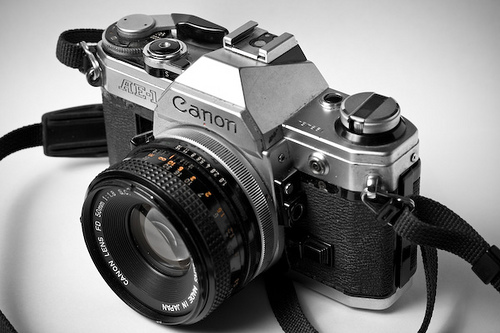
Man, now you’re talking! Dials, buttons, self-timer, little numbers all over the place, this was a serious camera! I could look through the viewfinder and see exactly what the camera would capture. I could change from a regular lens to a wide angle, telephoto and everything in-between! I could stop a birds wings flapping in mid-flight with a super-fast 1/1000thof a second shutter speed…this is the tool I needed all along!
I read the manual front to back dozens of times, bought books, played with each control until I knew how everything on that camera functioned. I shot roll after roll experimenting with backlit subjects, depth of field, long exposures, timed exposures, flash, fast shutter speeds, slow shutter speeds, print film, slide film, black and white, color, you name it.
As I developed my skills and artistic eye I started carrying my camera with me everywhere I could, even out on maneuvers and eventually arrived at the decision that I wanted to make capturing images my career. After I got out of the Army I used my VA money to attend a 2 year course in photography and film making at a technical school and eventually moved on to a four year degree in visual art at a state college.
During all this time Rick was my long-suffering photographic target as he was usually a co-conspirator of my explorations to the mountains, beaches and anywhere else we could quench our lust for adventure.

There is no doubt that I have photographed Rick more than any other person or thing. In digging through forty-five years of photos for his remembrance I gathered over 1500 pictures of him to edit through. It became our social contract that a camera would just always be there and he used to joke that he was a terrible model and I was only doing it to snap pics of him looking goofy.
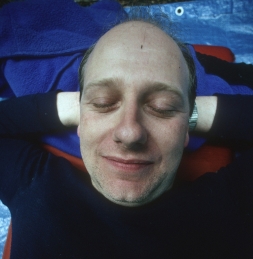

To call him my muse would be misleading, as he was often simply the only one to point the camera at, but he did act as inspiration as he surrendered to being directed, manipulated and cajoled into assisting me to get the images I wanted.
Over time, he learned I didn’t always want him to be posing or just doing cheesy snapshots, although these were always amusing. He knew not to always look at the camera to get more candid shots, to continue hiking or climbing past me instead of stopping when he got to me, to just act like I wasn’t there.
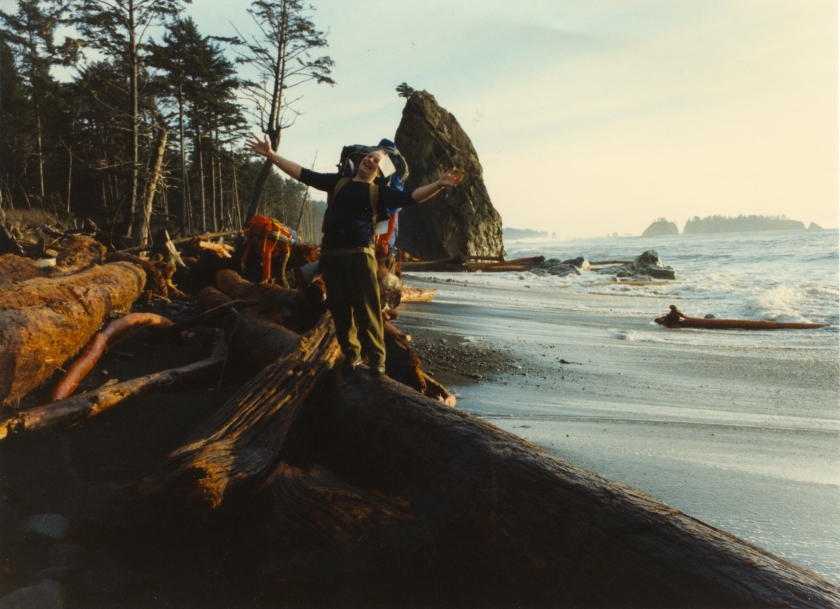
I couldn’t help laughing when he would begin coaching new recruits to our adventures as I would overhear him instructing others “he doesn’t want you to look at the lens” or, “just act like he isn’t there” and “just keep walking or he’ll make us do it again”.
He also cheerfully played along when I wanted multiple takes of the same thing to change exposures or otherwise fiddle around with my photographic necessities. I am sure there were times when having a camera relentlessly pointed at him was fatiguing and an imposition on his privacy, such as the many pics of him eating, drinking, sleeping, peeing, pooping and subsequently flipping me off, but he was always a great sport and being an extrovert I think he secretly liked all the attention.

As I prepare the memorial video for Rick, my mind constantly wanders off as I sift through all those years of photos. Over the years I have often thought of how these photos would become my memories as I grow older and begin to forget more and more details. I treasure each photo, some more than others, but all collectively telling stories of adventures with friends, family and transitory acquaintances.
As I dig through the boxes and boxes of slide pages and prints I come across one adventure or event after another. Some were very exciting and some were simply filled with moments of beauty, curiosity, or some other kind of implied importance since a frame or two was snapped. They are certainly not all masterpieces but they are all treasured more than gold to me.

Though there are thousands of images I can still recall each specific moment they were taken as I deliberately thought about composition, exposure, depth of field, motion, shutter speed and all the other things my training and experience had made me aware of over the years. But many of the memories locked in these frames are now only triggered when I view the photos… my actual memory having forgotten or stored away the experience to the far off memory attic until being reminded by their visual presence.

Often, it is the moments not shown in the photos that are triggered…those moments that were not snapped because someone’s safety was at stake, rain was pouring down, a snowstorm was raging, it was too hot or too cold or I was simply too lazy to stop, pull the heavy hunk of glass and metal out of its protective cocoon, change lenses and grab a pic. How I envy todays adventurers with their tiny GoPros and mobile phones to effortlessly record every small detail so easily.
In an activity where going light and fast was paramount, people did things like cut the handle off a toothbrush or take a poncho instead of a tent to save a few ounces. My struggle was always how many lenses do I really need and how much film to take along balanced with my allocated share of personal and team climbing gear and aching back from carrying too much.
One example of this internal struggle is deciding to leave my camera behind to save weight when I saw a climbing team slide into a crevasse far above us on Mt. Baker, a great story on it’s own. It was nearly sundown and I made the instant decision to only take bare essentials for the rescue up an evil looking, heavily crevassed icefall to get to them as fast as possible.

We quickly jammed our packs with a sleeping bag, water, stove, first aid kit, ice ax, crampons, rope, sleeping pads for insulation, splitting the load with Rick. As it turned out, we got to them with just enough light left to see they were in a terrible situation with blood, broken ones and one of them wedged into a constriction 40 feet down in the crevasse.
We performed difficult and stress-filled lifesaving operations to stabilize the victims and then spent the rest of the night down in a creaking, snapping and dripping crevasse trying not to fall into the dark abyss on either side of us.
We moved the worst off victim (hypothermic, concussion, serious neck injury, broken leg) to a small ice shelf, slightly longer than his body, with barely enough room for Rick and I to stand at either end.
We got him into the sleeping bag, melted some snow with the stove and stuffed a few heated water bottles around him to deal with his hypothermia. We then spent the rest of the night standing next to him as there was no place to sit on the small shelf.
We had nothing but time on our hands waiting for the main rescue team to arrive (that we hoped a Canadian team was bringing back after running back to the trail head and sounding the alarm) and tending the injured climber.
I started kicking myself in the ass for not bringing the camera up from base camp. The shots I could have taken! We chipped a couple of small alcoves in the walls of the glacier ice and put some candles from the first aid kit in them. They cast a crazy magical glow over the whole scene that made it look like a narrow crystal palace and I imagined taking long exposures to capture it all.
I envisioned images of Rick comically struggling to stay awake, close-ups of the crystal candle alcoves, pics looking straight up at the incredibly clear band of the star field visible through the narrow canyon of the crevasse, pics looking straight down from our tiny shelf of ice into the seemingly bottomless abyss of the crevasse, painting the ancient ice walls with the light of our headlamps to further illuminate the surreal crevasse, images of the paramedic rappelling down to us in the morning, shots of the big Navy Sea Stallion helicopter hovering directly above us as they hoisted the victim in the Stokes litter out of the crevasse in the early morning light, pics of my brand new, never slept-in mountain tent being blown 100 feet into the air at base camp as the huge helicopter landed there to pick up one of the other victims carried back down by the Canadian team. None of these images were taken, but they remain very vivid in my memory.

The power of the images I do have, to remind me of the ones I never managed to capture, is something I hope will never go away. These memories in-between the photographs are every bit as important to me, and are as subject to fading with age as the physical photos without careful curation and people to share them with.
A sleeping bag, water, stove, first aid kit, ice ax, crampons, rope, sleeping pads for insulation, splitting the load with Rick. As it turned out, we got to them with just enough light left to see they were in a terrible situation with blood, broken ones and one of them wedged into a constriction 40 feet down in the crevasse.
We performed difficult and stress-filled lifesaving operations to stabilize the victims and then spent the rest of the night down in a creaking, snapping and dripping crevasse trying not to fall into the dark abyss on either side of us.
We moved the worst off victim (hypothermic, concussion, serious neck injury, broken leg) to a small ice shelf, slightly longer than his body, with barely enough room for Rick and I to stand at either end.
We got him into the sleeping bag, melted some snow with the stove and stuffed a few heated water bottles around him to deal with his hypothermia. We then spent the rest of the night standing next to him as there was no place to sit on the small shelf.
We had nothing but time on our hands waiting for the main rescue team to arrive (that we hoped a Canadian team was bringing back after running back to the trail head and sounding the alarm) and tending the injured climber.
I started kicking myself in the ass for not bringing the camera up from base camp. The shots I could have taken! We chipped a couple of small alcoves in the walls of the glacier ice and put some candles from the first aid kit in them. They cast a crazy magical glow over the whole scene that made it look like a narrow crystal palace and I imagined taking long exposures to capture it all.
I envisioned images of Rick comically struggling to stay awake, close-ups of the crystal candle alcoves, pics looking straight up at the incredibly clear band of the star field visible through the narrow canyon of the crevasse, pics looking straight down from our tiny shelf of ice into the seemingly bottomless abyss of the crevasse, painting the ancient ice walls with the light of our headlamps to further illuminate the surreal crevasse, images of the paramedic rappelling down to us in the morning, shots of the big Navy Sea Stallion helicopter hovering directly above us as they hoisted the victim in the Stokes litter out of the crevasse in the early morning light, pics of my brand new, never slept-in mountain tent being blown 100 feet into the air at base camp as the huge helicopter landed there to pick up one of the other victims carried back down by the Canadian team. None of these images were taken, but they remain very vivid in my memory.
The power of the images I do have, to remind me of the ones I never managed to capture, is something I hope will never go away. These memories in-between the photographs are every bit as important to me, and are as subject to fading with age as the physical photos without careful curation and people to share them with.

I am deeply heartbroken that the one constant, the focus of so many of these images and wonderful experiences that began so many years ago, with such a comically dismal start, is no longer here to sit with me, have a glass of whiskey, giggle and laugh and tell new lies about each and every one of them. I will miss you my friend, but I will have to find some comfort in raising a glass and re-living a photo or two of our time together.









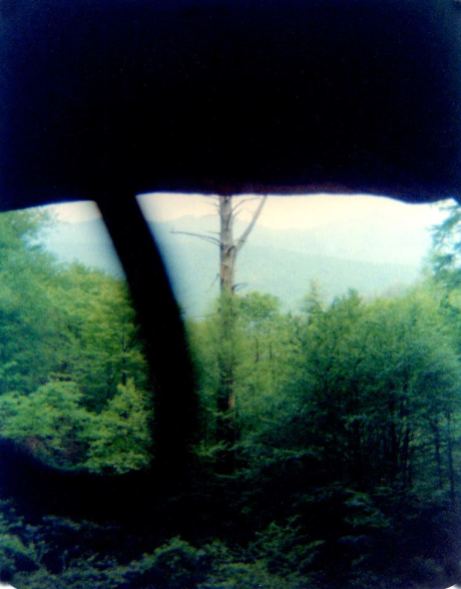







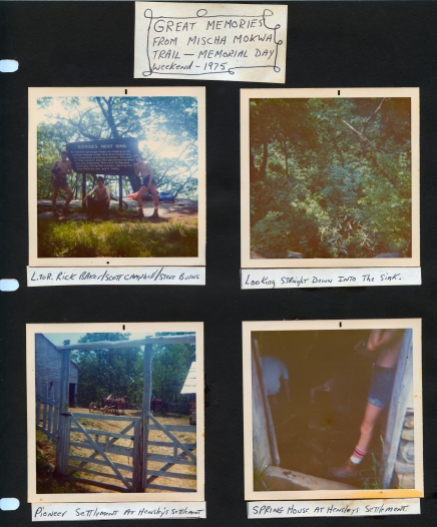
So I am sitting here at my daughters house with my wife Cara and Daughter Katy in Arizona. Looking at your pictures and Katy (who is now 36 yrs old) starts laughing at the time we picked her up at her Mom’s house in British Columbia when she was 16 yrs old after we were climbing cliffs at Squamish and Whistler BC (before the classic Pink Floyd weekend) and brought her back down with us to my home in Chehalis. We were in our traditional climbing gear (long johns and shorts) and smelled like we had not taken a shower in 3 days. We were stopped crossing the border and had to convince the border guard that 1. she was my daughter and 2. she was glad to be with us. We had a few more border crossings that were alot more interesting down the road.
LikeLiked by 1 person
LOL, I remember that one very clearly.And we hadn’t showered for 3 days 🙂
LikeLike
I remember her starting to argue with the US Customs Gaurd about not needing written permission, in which we all told her to be quiet and not argue with the guy allowing back into the country. Those days the four of us spent climb in BC were a lot of fun. Somehow we all just seem to fit.
LikeLike
While you talk about all the photos taken, I remember all the videos shot. You waiting for Rick or I to fall off a log into a river, or just to catch up to you. Tom never really got the point of pretending the camera wasn’t there. 🙂
LikeLike